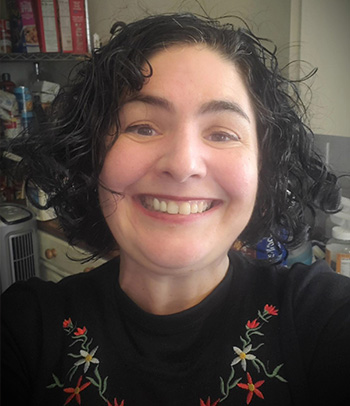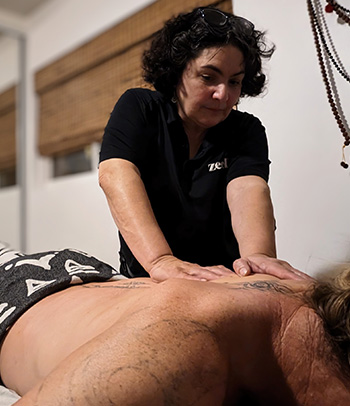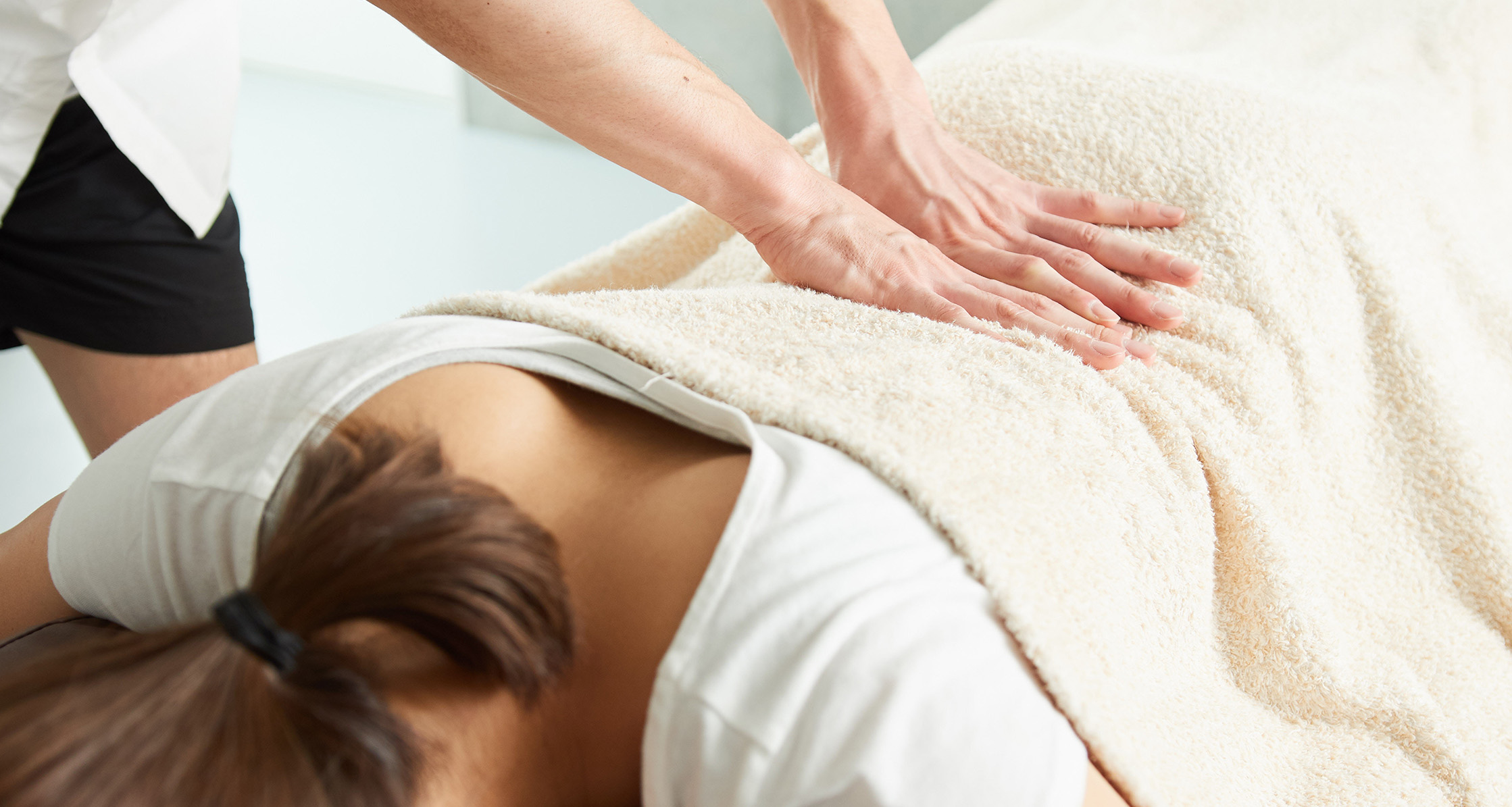“I love to see people smile because they have less pain or improved mobility.” – Sherre Bischoff, medical massage therapist, on the benefits of massage therapy.
Each of us defines health and wellness in our own way. For some, it may mean exercising at a gym a few times a week. For others, it may mean eating a vegetarian diet or spending time in the fresh air each day. It may include regular checkups, mental health care appointments, weekly yoga classes and more.
Through the Department of Veterans Affairs (VA) and its Whole Health approach to health care, Veterans have access to a wide range of evidence-based complementary treatments to help meet their unique health care needs, including massage therapy, tai chi, yoga and much more.
Sherre Bischoff is a medical massage therapist within VA’s Community Care Network (CCN) Region 4. Sherre works with a TriWest in-network provider group with thousands of medical massage therapists serving VA’s CCN. She uses medically prescribed massage therapy delivered in Veterans’ homes to help improve their quality of life and address different health issues such as muscle and joint pain, hypertension, mobility limitations and more.
Meet Sherre
Sherre is a board-certified massage therapist who has practiced massage therapy for the past 23 years. Within those 23 years, Sherre has spent time working in clinics as well as operating her own private practice, and has been an instructor at a massage therapy college. 
Along the way, she has studied many different modalities of massage therapy, each with its own unique system of healing – everything from acupressure and deep tissue massage to neuromuscular and myofascial release.
For the past three years, Sherre has used her experience and expertise to help Veterans in their homes, providing medically prescribed massage therapy sessions.
“My job as a massage therapist is to use the power of healing touch. Our team works with every patient, making sure they are taken care of,” Sherre said.
VA aims to increase Veterans’ access to health care by providing care options within their local communities. By showing up to a Veteran’s door, Sherre and other in-home massage therapists help save the Veteran travel time and provide additional appointment times on nights and weekends. For a Veteran who may have mobility issues, who is not sleeping well or who lives too far away from a clinic, this gives them a chance to try massage therapy in a way that’s convenient and personalized.
The Power of Massage Therapy
According to Sherre, massage therapy has many benefits.
“Through massage, stretching and passive movements, I am able to help relieve chronic pain and stress, improve range of motion, reduce headaches and migraines, help balance the body and reduce severe tension in the muscles,” she said.
There is evidence to support Sherre’s belief in the power of massage. VA research suggests that massage can have many health benefits, including:
- Reduced anxiety and depression (multiple sessions were actually found to have comparable benefits to psychotherapy)
- Lowered blood pressure and decreased heart rate
- Reduced pain (in lower back, neck, shoulders and more)
Sherre’s experience supports this research, and she goes on to note other benefits of consistent therapeutic massage such as such as:
- Relief from severe chronic pain and tightness or tension in your muscles
- Improved blood circulation in the body
- Improved sleep
- Decreased arthritis and rheumatoid arthritis pain, as well as joint replacement pain
- Increased range of motion
- Elimination or a decreased number of migraines and headaches
- Reduced anxiety, nausea, depression and fatigue in patients fighting cancer
- Better pain management and stress levels in post-surgical patients
- Reduced or eliminated over-the-counter pain medication or prescription opioids
Common Conditions Treated With Massage Therapy
VA promotes massage therapy as a tool within its Whole Health Care approach for a number of different reasons. It has been used for everything from managing symptoms of post-traumatic stress disorder (PTSD) to dealing with chronic pain.
“People seek out massage therapy for many reasons. A person may want to simply promote wellness or fitness, relaxation or stress relief. Or a person may have carpal tunnel syndrome, scoliosis, a sports injury or tendonitis,” Sherre shared.
According to a study by the Centers for Disease Control and Prevention (CDC), Veterans suffer from much higher rates of chronic pain than the rest of the population. While health care providers used to think that opioids were a safe way to reduce chronic pain, VA’s Opioid Safety Initiative is working to minimize harm and increase patient safety in patients requiring opioid therapy. VA also outlines several non-medication treatment alternatives that can be included in a health care plan for chronic pain, including acupuncture, chiropractic and physical therapy.
Massage therapy offers another alternative, Sherre noted. “Massage therapy can give clients a drug-free choice to alleviate chronic pain.”
Advice for Veterans Thinking About Massage Therapy
With more than two decades of experience, Sherre understands how deeply personal massage therapy can be. She recommends that Veterans talk to their VA health care provider to ask questions about whether massage therapy is an option.
“Patients must trust their massage therapists and know they are in a safe place,” she said.
“It’s important to have a safe, secure, trusting environment.”
“This is your healing journey and it’s important that you receive the best care possible,” she said.
Success Stories From Veterans Using Massage Therapy
Sherre gets her inspiration directly from the success of the patients she treats. “I am inspired to work in this field because I want to help people become pain-free. I love to see people smile because they have less pain or improved mobility,” she shared.
Sherre recalled a Veteran who suffered a traumatic brain injury (TBI). The patient had reduced range of motion, chronic pain, and severe tightness in the shoulders, along with severe migraines three to four times a week – migraines so bad the patient couldn’t get out of bed and had to be in the dark. After the 10th massage therapy session, the patient said the migraines were gone or mild and had improved range of motion in the shoulders and was in less pain. After the 12th session, the migraines were completely gone.
Sherre remembered another Veteran who suffered from chronic lower back pain.
“The patient had trouble standing, sitting, walking and bending, and was sleeping with a pillow under the hips for support,” she said.
After the sixth massage therapy session, the Veteran’s sleep improved, and the chronic pain became more moderate. By the 12th session, the Veteran was able to walk farther distances, had more mobility, had only mild tightness, and made tremendous overall improvement.
Resources
VA offers medical massage therapy as a complementary treatment option for Veterans enrolled in VA health care.
- Discuss medical massage therapy with your health care provider to determine if it could benefit your health and wellness routine and whether it’s covered by your VA benefits.
- Learn more about the different types of massage therapy, how it works and what conditions it may benefit.
- Read about Veterans who have successfully used Whole Health treatments, such as medical massage therapy, acupuncture, tai chi and more.
Editor’s Note – Thank you to medical massage therapist Sherre Bischoff, of Zeel, for participating in this article. Zeel is one of TriWest’s trusted group providers in network caring for Veterans, including wellness and integrative health. If you are a network provider caring for Veterans with a story about Veteran care to share, please email us at Media@TriWest.com.







